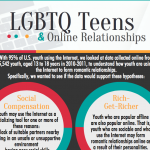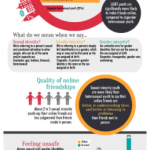Teen sexting isn't always a problem behavior, but part of sexual exploration. Although "sexting" is sometimes portrayed as a recent problem caused by new technologies (e.g., cell phones, social media), people have shared self-created nude photos since the days of the Polaroid camera. Nonetheless, parents may be concerned what it may mean if their child is sharing sexually explicit photos of themselves through technology. In our new infographic, we highlight our study findings on some ways teenagers who sext may differ from teens who do not sext. This infographic also suggests how we can recognize that sexting is not so much a problem behavior of the digital age, but an indication that youth may need mental health support and learn behaviors for healthy sex. Data are from the Teen … [Read more...]
To Use or Not Use Condoms? Gay, Bi, Queer Teen Guys Tell Us
In light of International Condom Day, our new infographic showcases quotes from our online discussion with gay, bisexual, and queer teen guys on condom use. Young men who have sex with men are among the groups with the fastest growing rates of new cases of HIV [1]. Therefore, encouraging gay, bisexual, and queer (GBQ)-identifying teenage men to use condoms is an important preventive step. As part of our formative work to develop a salient healthy sexuality program for GBQ young men [2], we held an online discussion with 75 GBQ teenagers. Their resulting feedback shed insight on the types of their challenges that they faced in getting and using condoms, as well as some of the reasons why they choose to use or not use condoms. In light of International Condom Day on February 13th [3], … [Read more...]
How Cell Phones Will Be a Bigger Part of Our Health in 2016
Advances in mobile technology allow for sophisticated mobile health. With 9 in 10 Americans owning some kind of cell phone, 2016 is looking to be an exciting year for mobile health - that is, health care or health information delivered through mobile devices like cell phones, tablets, and smartphones [1-3]! Mobile health is definitely a game-changer: It has the potential to keep costs low and increase access to health information and medical attention – especially for those who may not have easy access to care (for instance, because they live in rural areas) [1]. Smartphones Getting Smarter With the number of Americans who own smartphones doubling in the past five years, digital trend watchers are really focusing on the potential for smartphones to change mobile … [Read more...]
Why Aren’t Gay, Bi, Queer Teen Guys Getting Tested for HIV?
GBQ guys name some of their biggest challenges to getting HIV tested. In the U.S., human immunodeficiency virus (HIV) affects 13- to 24-year-old men who have sex with men (MSM) more than any other age or gender group [1]. Indeed, new HIV infections are increasing fastest among adolescent MSM compared to all other groups [1]. While HIV treatments have improved a lot in the past decade, these treatments are more successful when the virus is detected earlier [2, 3]. This means testing is an important part of ending the epidemic [3]. However, only an estimated 1 in 2 gay and bisexual young men living with HIV are aware of their infection [1]. Consistent with this finding, we recently collected data from just over 300 gay, bisexual, and queer (GBQ) teen guys, and only 3 in 10 sexually … [Read more...]
Infographic: How Bullying Affects Youth
We hear a lot about bullying these days. Some people think it is just youth being mean to one another - but bullying is different. While peer harassment is somewhat common between youth, bullying happens less frequently. The effects of bullying on youth who experience it are also greater. By learning more about what bullying is and how it affects youth, we can do more to address it and prevent it. Learn more with our infographic, How Bullying Affects Youth. Learn more about our research at Center for Innovative Public Health Research. Find us on Google+, Twitter, and Facebook. Acknowledgments: Thanks to Emilie Chen for her contributions to this blog. … [Read more...]
Online Activities of Youth who Engage in Self-Harm Behaviors
Following up last month's post on websites about self-harm, we explore what young people who engage in self-harm behavior do online, in our new infographic. Compared to youth who do not engage in self-harm, youth with self-harm behaviors use the Internet in different ways. This information may provide channels through which distressed youth can be reached. For full details, visit the infographic Online Activities of Youth who Engage in Self-Harm Behaviors. Learn more about our research at Center for Innovative Public Health Research. Find us on Google+, Twitter, and Facebook. Acknowledgments: Thanks to Dr. Kimberly Mitchell and Emilie Chen for their contributions to this blog. … [Read more...]
Self-Harm Websites and Teens Who Visit Them
We can all agree the Internet brings us together. It improves our lives in tons of ways (think: social media, online shopping, access to health-improving information). At the same time, this large virtual space also accommodates niche communities that encourage unhealthy or harmful behavior. One example is the online communities that share self-harm experiences and, in some cases, encourage self-harm or suicide [1]. Self-harm behavior involves intentionally injuring or hurting oneself (e.g., cutting) [2]. Although self-harming behavior may indicate depression or serious mental health conditions that are associated with suicidal intentions, people do not always self-harm because they want to die by suicide [2]. It is important to understand that this behavior is not the same as a suicide … [Read more...]
Are Teens Going Online to Form Romantic Relationships?
The Internet has certainly changed the way that youth today socialize with one another, but has it also affected the way teenagers meet romantic partners (i.e., boyfriends, girlfriends)? Moreover, do lesbian, gay, bisexual, transgender, and queer (LGBTQ) youth, who may have less access to available partners as compared to non-LGBTQ youth, use the Internet for finding romantic partners in different ways than non-LGBTQ youth? These questions are explored using data from our Growing up with Media study, in which we surveyed a nationally representative sample of over 5,000 youth, aged 13 to 18 years in 2010-2011. To see our findings, be sure to check out our new infographic: LGBTQ Teens and Online Relationships. For more reading, check out our Growing up with Media infographic on … [Read more...]
Online Social Support for LGBT Teens
From feeling accepted to having a sense of self-worth, social support is an important aspect of a person's well-being [1]. Thanks to social media technology, many youth can find social support and form beneficial friendships online. This is especially important for lesbian, gay, bisexual, and transgender (LGBT) youth, who can more easily find friends who are understanding online than in person. However, the benefits of online friendships are not without its limits: Negative experiences, such as harassment, can still occur online. In-person friendships continue to be an important factor for reducing the likelihood LGBT youth victimization. To learn more, check out our new infographic, illustrating national data about online experiences: Online Social Support for LGBT Teens(link is … [Read more...]
Talking Online Can Be Life Changing for Sexual Minority Guys
Online discussions about healthy sex help sexual minority guys find support. As we explored in a previous post, the Internet can be an important source of health information and social support for lesbian, gay, and bisexual (LGB) teens [1]. Our recent study builds on this finding. We conducted online focus groups (i.e., message board discussions) with gay, bisexual, and queer teen guys. While online message boards may seem like old news in the world of social networking, they can be a great way to bring people with similar interests together to have a private conversation. This opportunity to connect can be particularly important for people who may be isolated and not have people they can relate to in their face-to-face lives. For gay and bisexual teens, this can include having people … [Read more...]








